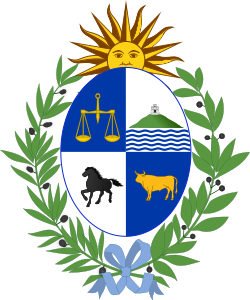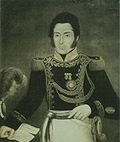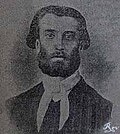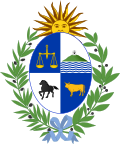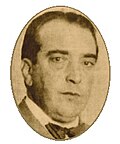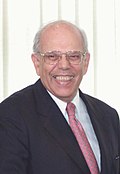| No. | Portrait | Name
(Birth–Death) | Term of office | Party | Elected | Notes |
|---|
| (7) |  | Juan Antonio Lavalleja
(1784–1853) | 28 June 1830 | 24 October 1830 | | — | — | Governor and Provisional Captain General. Appointed by the General Constituent Assembly. |
|---|
| (9) | 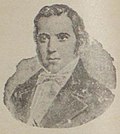 | Luis Eduardo Pérez
(1774–1841) | 24 October 1830 | 6 November 1830 | | — | — | President of the Senate exercising the Executive Power. |
|---|
| 10 |  | Fructuoso Rivera
(1784–1854) | 6 November 1830 | 24 October 1834 | | — | 1830 | 1st Constitutional President, elected by the General Assembly. Resigned. |
|---|
| 11 |  | Carlos Anaya
(1777–1862) | 24 October 1834 | 1 March 1835 | | Colorado | — | President of the Senate exercising the Executive Power. |
|---|
| 12 |  | Manuel Oribe
(1792–1857) | 1 March 1835 | 24 October 1838 | | National | 1835 | 2nd Constitutional President, elected by the General Assembly. Resigned. |
|---|
| 13 |  | Gabriel Antonio Pereira
(1794–1861) | 24 October 1838 | 1 March 1839 | | Colorado | — | President of the Senate exercising the Executive Power. |
|---|
| 10 |  | Fructuoso Rivera
(1784–1854) | 1 March 1839 | 1 March 1843 | | Colorado | 1839 | 3rd Constitutional President, elected by the General Assembly. |
|---|
| 12 |  | Manuel Oribe
(1792–1857) | 16 February 1843 | 8 October 1851 | | National | — | Self-proclaimed president of the Gobierno del Cerrito, during the Uruguayan Civil War. |
|---|
| 8 |  | Joaquín Suárez
(1781–1868) | 1 March 1843 | 15 February 1852 | | Colorado | — | President of the Senate exercising the Executive Power. President of the Gobierno de la Defensa, during the Uruguayan Civil War. |
|---|
| 14 |  | Bernardo Prudencio Berro
(1803–1868) | 15 February 1852 | 1 March 1852 | | National | — | President of the Senate exercising the Executive Power. |
|---|
| 15 | 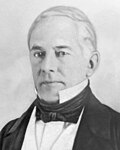 | Juan Francisco Giró
(1791–1863) | 1 March 1852 | 25 September 1853 | | National | 1852 | 4th Constitutional President, elected by the General Assembly. Ousted from office by a coup d'état. |
|---|
| 16 |  | Venancio Flores
(1808–1868) | 25 September 1853 | 12 March 1854 | | Colorado | — | Triumvirate. Fructuoso Rivera and Juan Antonio Lavalleja died in office. |
|---|
| 10 |  | Fructuoso Rivera
(1784–1854) | 25 September 1853 | 13 January 1854 | | Colorado |
|---|
| 7 |  | Juan Antonio Lavalleja
(1784–1853) | 25 September 1853 | 22 October 1853 | | — |
|---|
| 16 |  | Venancio Flores
(1808–1868) | 12 March 1854 | 10 September 1855 | | Colorado | 1854 | 5th Constitutional President, elected by the General Assembly. Resigned. |
|---|
| 17 | | Luis María Lamas
(1793–1864) | 29 August 1855 | 10 September 1855 | | Conservative | — | Self-proclaimed president after the Rebellion of the Conservatives ( es ). |
|---|
| 18 | | Manuel Basilio Bustamante
(1785–1863) | 10 September 1855 | 15 February 1856 | | Colorado | — | President of the Senate exercising the Executive Power. |
|---|
| 19 | | José María Plá
(1794–1869) | 15 February 1856 | 1 March 1856 | | Colorado | — | President of the Senate exercising the Executive Power. |
|---|
| 13 |  | Gabriel Antonio Pereira
(1794–1861) | 1 March 1856 | 1 March 1860 | | Colorado | 1856 | 6th Constitutional President, elected by the General Assembly. |
|---|
| 14 |  | Bernardo Prudencio Berro
(1803–1868) | 1 March 1860 | 1 March 1864 | | National | 1860 | 7th Constitutional President, elected by the General Assembly. |
|---|
| 20 |  | Atanasio Cruz Aguirre
(1801–1875) | 1 March 1864 | 15 February 1865 | | National | — | President of the Senate exercising the Executive Power. Resigned after the Brazilian invasion. |
|---|
| 21 |  | Tomás Villalba
(1805–1886) | 15 February 1865 | 20 February 1865 | | National | — | President of the Senate exercising the Executive Power. Resigned after the Brazilian invasion. |
|---|
| 16 |  | Venancio Flores
(1808–1868) | 20 February 1865 | 15 February 1868 | | Colorado | — | De facto president after the Brazilian invasion. Assumed power as Provisional Governor for 3 years. |
|---|
| 22 |  | Pedro Varela
(1837–1906) | 15 February 1868 | 1 March 1868 | | Colorado | — | President of the Senate exercising the Executive Power. |
|---|
| 23 |  | Lorenzo Batlle
(1810–1887) | 1 March 1868 | 1 March 1872 | | Colorado | 1868 | 8th Constitutional President, elected by the General Assembly. |
|---|
| 24 |  | Tomás Gomensoro Albín
(1810–1900) | 1 March 1872 | 1 March 1873 | | Colorado | — | President of the Senate exercising the Executive Power. |
|---|
| 25 |  | José Eugenio Ellauri
(1834–1894) | 1 March 1873 | 22 January 1875 | | Colorado | 1873 | 9th Constitutional President, elected by the General Assembly. Resigned. |
|---|
| 22 |  | Pedro Varela
(1837–1906) | 22 January 1875 | 10 March 1876 | | Colorado | — | 10th Constitutional President, appointed by the General Assembly after the resignation of Ellauri. Ousted by a coup d'état. |
|---|
| – | 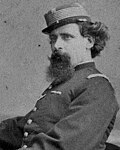 | Lorenzo Latorre
(1844–1916) | 10 March 1876 | 1 March 1879 | | Colorado | — | Assumed power as Provisional Governor. |
|---|
| 26 | 1 March 1879 | 15 March 1880 | 1879 | 11th Constitutional President, elected by the General Assembly. Resigned. |
|---|
| 27 |  | Francisco Antonino Vidal
(1825–1889) | 15 March 1880 | 1 March 1882 | | Colorado | — | 12th Constitutional President, appointed as president by the General Assembly to finish the presidential period 1879–1883. Resigned. |
|---|
| 28 | 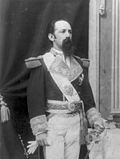 | Máximo Santos
(1847–1889) | 1 March 1882 | 1 March 1886 | | Colorado | — | 13th Constitutional President, appointed by the General Assembly for a term of 4 years. |
|---|
| 27 |  | Francisco Antonino Vidal
(1825–1889) | 1 March 1886 | 24 May 1886 | | Colorado | 1886 | 14th Constitutional President, elected by the General Assembly. Resigned. |
|---|
| 28 |  | Máximo Santos
(1847–1889) | 24 May 1886 | 18 November 1886 | | Colorado | — | President of the Senate exercising the Executive Power. Resigned. |
|---|
| 29 |  | Máximo Tajes
(1852–1912) | 18 November 1886 | 1 March 1890 | | Colorado | — | 15th Constitutional President, appointed as president by the General Assembly to finish the presidential period 1886–1890. |
|---|
| 30 |  | Julio Herrera y Obes
(1841–1912) | 1 March 1890 | 1 March 1894 | | Colorado | 1890 | 16th Constitutional President, elected by the General Assembly. |
|---|
| 31 |  | Duncan Stewart
(1833–1923) | 1 March 1894 | 21 March 1894 | | Colorado | — | President of the Senate exercising the Executive Power. |
|---|
| 32 |  | Juan Idiarte Borda
(1844–1897) | 21 March 1894 | 25 August 1897 | | Colorado | 1894 | 17th Constitutional President, elected by the General Assembly. Assassinated. |
|---|
| 33 |  | Juan Lindolfo Cuestas
(1837–1905) | 25 August 1897 | 10 February 1898 | | Colorado | — | President of the Senate exercising the Executive Power. |
|---|
| 10 February 1898 | 15 February 1899 | De facto president following a self-coup. Resigned. |
| 34 |  | José Batlle y Ordóñez
(1856–1929) | 15 February 1899 | 1 March 1899 | | Colorado | — | President of the Senate exercising the Executive Power. |
|---|
| 33 |  | Juan Lindolfo Cuestas
(1837–1905) | 1 March 1899 | 1 March 1903 | | Colorado | 1899 | 18th Constitutional President, elected by the General Assembly. |
|---|
| 34 |  | José Batlle y Ordóñez
(1856–1929) | 1 March 1903 | 1 March 1907 | | Colorado | 1903 | 19th Constitutional President, elected by the General Assembly. |
|---|
| 35 | 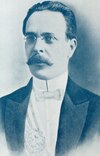 | Claudio Williman
(1861–1934) | 1 March 1907 | 1 March 1911 | | Colorado | 1907 | 20th Constitutional President, elected by the General Assembly. |
|---|
| 34 |  | José Batlle y Ordóñez
(1856–1929) | 1 March 1911 | 1 March 1915 | | Colorado | 1911 | 21st Constitutional President, elected by the General Assembly. |
|---|
| 36 |  | Feliciano Viera
(1872–1927) | 1 March 1915 | 1 March 1919 | | Colorado | 1915 | 22nd Constitutional President, elected by the General Assembly. |
|---|
